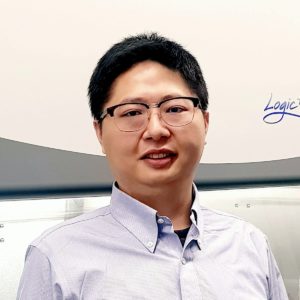 Dr. Weiqiang Chen is an Assistant Professor in the Departments of Mechanical and Aerospace Engineering and Biomedical Engineering at New York University. He received his B.S. in Physics from Nanjing University in 2005 and M.S. degrees from Shanghai Jiao Tong University in 2008 and Purdue University in 2009, both in Electrical Engineering. He earned his Ph.D. degree in Mechanical Engineering from the University of Michigan in 2014. He is the receipt of the National Institute of Biomedical Imaging and Bioengineering Trailblazer Award, the American Heart Association Scientist Development Award, the NYU Whitehead Fellowship, the 2013 Baxter Young Investigator Award, the University of Michigan Richard F. & Eleanor A. Towner Prize for Outstanding PhD Research, and the ProQuest Distinguished Dissertation Award. Dr. Chen’s research interests focus on Lab-on-a-Chip, biomaterials, mechanobiology, stem cell biology, caner biology, and immune engineering.
Dr. Weiqiang Chen is an Assistant Professor in the Departments of Mechanical and Aerospace Engineering and Biomedical Engineering at New York University. He received his B.S. in Physics from Nanjing University in 2005 and M.S. degrees from Shanghai Jiao Tong University in 2008 and Purdue University in 2009, both in Electrical Engineering. He earned his Ph.D. degree in Mechanical Engineering from the University of Michigan in 2014. He is the receipt of the National Institute of Biomedical Imaging and Bioengineering Trailblazer Award, the American Heart Association Scientist Development Award, the NYU Whitehead Fellowship, the 2013 Baxter Young Investigator Award, the University of Michigan Richard F. & Eleanor A. Towner Prize for Outstanding PhD Research, and the ProQuest Distinguished Dissertation Award. Dr. Chen’s research interests focus on Lab-on-a-Chip, biomaterials, mechanobiology, stem cell biology, caner biology, and immune engineering.
Read his latest Emerging Investigator Series article “An integrated adipose-tissue-on-chip nanoplasmonic biosensing platform for investigating obesity-associated inflammation“ and read more about him in the interview below:
Your recent Emerging Investigator Series paper focuses on “An Integrated Adipose-Tissue-On-Chip Nanoplasmonic Biosensing Platform for Investigating Obesity-associated Inflammation”. How has your research evolved from your first article to this most recent article?
We have previously been interested in developing microfluidic biosensing systems for immune cell cytokine detections. Quantitative measurements of the cytokine-producing capacity of different immune cells are critically important for characterizing the immune cell functions and defining the “immune phenotypes” of patients for clinical diagnosis and interventions. Although many advanced biosensing techniques have been purposed for cytokine profiling, there are no clinically available methods that integrate high-resolution immune cell monitoring and multiplexed cytokine detection together in its native tissue microenvironment, which is a big hurdle to understand the cellular immunophenotype behaviors during disease progression. This has inspired us to consider of combining the label-free nanoplasmonic biosensors with an Adipose-Tissue-on-Chip system reported in the recent article to quantitatively characterize obesity-associated dynamic cytokine secretion behaviors in a complex biomimetic adipose tissue microenvironment.
What aspect of your work are you most excited about at the moment?
I am most excited about the potential of our research for future applications in personalized medicine.
In your opinion, what do you think the contribution of disease-on-a-chip models for personalised medicine is likely to be?
Traditional medicine, which mostly relies on test of treatment on animal models, has many limitations. This is because the traditional animal models cannot mimic human pathophysiology accurately. Alternatively, the disease-on-a-chip platform can mimic an ideal microenvironment of human pathologic tissue, which enables a more accurate way to test the medicine activity under molecular- and cellular-scale in human organ tissue in vitro. Particularly, the cellular immunophenotype behavior is highly correlated with the tissue microenvironment. Unquestionably, integrating in situ cellular and molecular immune profiling in an organotypic setting can provide a reliable and accurate screening to characterize cell functions in its native tumor microenvironment. More importantly, due to the heterogeneity between individual human being, even for patients who are diagnosed with the same disease, their response to a same medicine treatment can be diversified. The minimized microfluidic disease-on-a-chip model can be derived from the specific patient’s cells or explanted pathophysiology tissue, allows parallel screening of multiple medical treatments in personalized manner. Therefore, this technology will provide the most efficient way to identify the most effective personalized medical options before applying to the patient’s own self.
What do you find most challenging about your research?
The most challenging part about our research is to accelerate translational technologies from the benchtop to the clinic to make a real impact on patients. A number of obstacles, including differences in culture between basic and clinical researchers, difficulty in developing and sustaining interdisciplinary collaborations, inadequate training and knowledge in medical sciences, and lack of funding, resources, or infrastructure, have limited the opportunities for basic bioengineering investigators, including myself, to conduct translational research. Therefore, my lab has established strong collaboration with many clinical colleagues at NYU Langone Health. Their expertise will contribute most significantly to our research from the biology and clinical aspects. Through this, I believe our engineering methods can introduce real impact to translational clinical research.
In which upcoming conferences or events may our readers meet you?
We will present our research in the upcoming Biomedical Engineering Society (BMES) Annual Meeting and the International Conference on Miniaturized Systems for Chemistry and Life Sciences (µTAS 2018).
How do you spend your spare time?
I enjoy watching movies, spending time with family and friends, and traveling to different cities around the world.
Which profession would you choose if you were not a scientist?
I would probably choose a career in social science.
Can you share one piece of career-related advice or wisdom with other early career scientists?
Something I could suggest is to be patient in testing your new ideas. It always take some time, normally years, for a scientist to prove a new scientific idea and develop it into practical methods or solutions.










